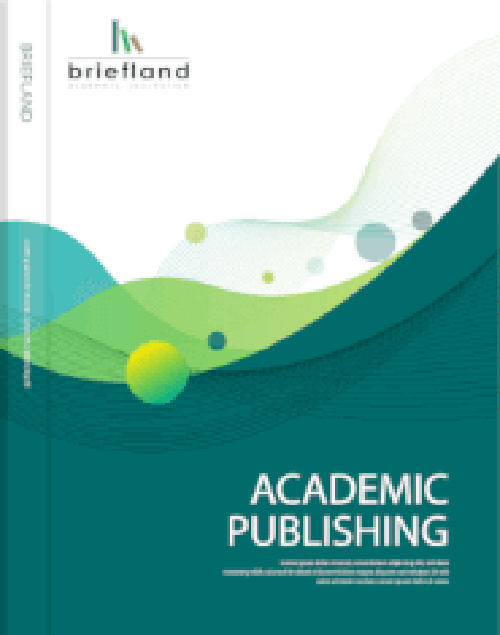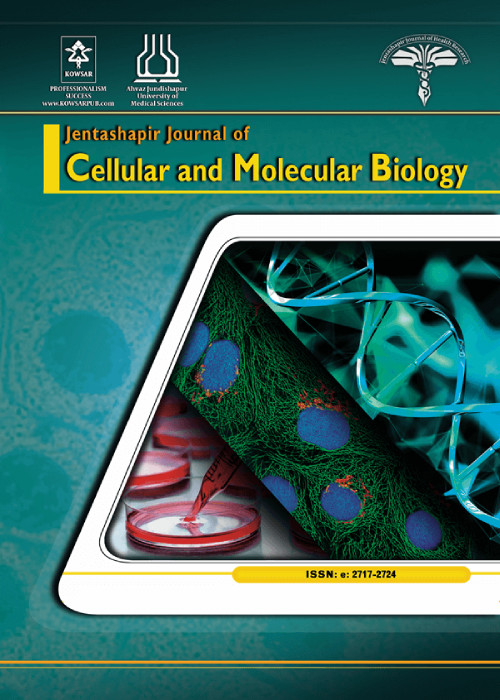فهرست مطالب

Jentashapir Journal of Cellular and Molecular Biology
Volume:13 Issue: 2, Jun 2022
- تاریخ انتشار: 1401/06/07
- تعداد عناوین: 7
-
-
Page 1Context
Statins are administered to decrease atherosclerosis in patients with coronary heart disease. These drugs enhance the risk of diabetes by affecting islets insulin secretion.
ObjectivesTherefore, this systematic review investigates the effect of statins on insulin secretion of islets of Langerhans in the related original studies.
MethodsA preliminary search was performed in the PubMed, Scopus, Web of Science, and ProQuest databases. The search strategy terms were statin (hydroxymethylglutaryl-CoA reductase inhibitors), insulin secretion, and islets of Langerhans. The search elements were evaluated using the Mesh term system. Limits were used to include only review articles and no limits were set on language. The quality of the method and risk of bias was assessed by its tool.
ResultsAfter removing irrelevant articles to the subject, 20 articles fulfilled the inclusion criteria. In vivo studies revealed that pravastatin and rosuvastatin increase and decrease islets insulin secretion, while atorvastatin and fluvastatin reduced this variable, and pitavastatin had no effect. The results of in vitro studies showed that pravastatin and induced both increasing and decreasing effects on insulin secretion from the pancreatic islet cells. Also, administration of atorvastatin, rosuvastatin, fluvastatin, pitavastatin, simvastatin, and lovastatin decreased islet insulin secretion in the medium.
ConclusionsPravastatin could enhance pancreatic islet insulin secretion while other statins reduced this variable. Finally, the contradictory effect of statins on islets’ insulin secretion can indicate the existence of laboratory and clinical research in this regard.
Keywords: Hydroxymethylglutaryl-CoA Reductase Inhibitors, Islet of Langerhans, Insulin Secretion -
Page 2Background
Many men in the world are infertile at reproductive age. One of the causes of male infertility is the side effects of chemotherapy drugs. Doxorubicin (DOX) is a tetracycline used in chemotherapy that has been shown to have adverse effects on testicular tissue.
ObjectivesThe simultaneous effect of high-intensity aerobic exercise and crocin (Cr) consumption on doxorubicin-induced testicular tissue has not been studied. Therefore, the aim of this study was to investigate the interaction between exercise and Cr consumption on spermatogenesis and expression of lutein hormone receptor (LHR) in testicular tissue of rats injected with doxorubicin.
MethodsThirty male Wistar rats were randomly divided into five groups (n = 6), including (1) healthy control, (2) doxorubicin, (3) doxorubicin + 10 mg/kg body weight (kg.bw) Cr, (4) doxorubicin + high intensity interval training (HIIT) and (5) doxorubicin + aerobic training with 10 mg/kg.bw Cr. Rats in groups 3 and 5 received Cr daily at specific doses orally, and groups 4 and 5 performed aerobic training (2 - 8 rep × 2 min at 80 - 110% Vo2max) five days/w. Also, groups 2 to 5 received two mg/kg of doxorubicin peritoneally seven times throughout the study. Expression of LHR and spermatogenesis was measured by immunohistochemistry (IHC) and hematoxylin and eosin (H&E), respectively.
ResultsData analysis showed a significant decrement in the spermatogenesis and expression of LHR in the doxorubicin group compared with the control group (P ≤ 0.0001). Also, the interaction of HIIT and Cr caused the most significant increase in LHR expression and spermatogenesis (P ≤ 0.03). The effect of HIIT on LHR expression and spermatogenesis was higher than that of Cr consumption (P ≤ 0.05).
ConclusionsTo prevent the harmful side effect of doxorubicin on testicular tissue HIIT and Cr consumption are recommended. Also, the positive effect of HIIT was significantly higher than Cr consumption.
Keywords: Aerobic Exercise, Crocin, Doxorubicin, Leydig Cells, LH Receptors, Spermatogenesis -
Page 3Background
Myricetin (MCN), a dietary flavonoid, is present in walnuts, fruits, vegetables, tea, and berries and has been suggested as an anti-inflammatory, antiplatelet, antimicrobial, antioxidant, and antiviral drug.
ObjectivesThis study aimed to investigate whether the necroptosis pathway involves the toxic impacts of myricetin (MCN) on the colon adenoma-carcinoma HT-29 cells.
MethodsFor 48 hours, HT-29 cells were exposed to 50 µM MCN or three mM Nec-1 (Necrosatine-1, a necroptosis preventive). Apoptosis, cell viability, and expression of necroptosis-related genes, including MLKL (mixed lineage kinase domain-like protein), RIPK1 (receptor-interacting protein kinase-1), and RIPK3, were evaluated.
ResultsMCN caused a noticeable decline in the survival of HT-29 cells. In contrast to the slight change in the apoptosis index in HT-29 cells, MCN considerably increased the necrosis index. MCN could enhance the expression of MLKL, RIPK1, and RIPK3 in the HT-29 cells. The co-treatment of MCN with Nec-1 resulted in a significant elevation in HT-29 cell survival. Nec-1 could decrease the necrosis index and expression of necroptosis-related proteins in the MCN-exposed HT-29 cells.
ConclusionsThese findings demonstrated that MCN effectively induced cell death in HT-29 cells by activating the necroptosis pathway
Keywords: Myricetin, Necroptosis, Colon Cancer, Cytotoxicity -
Page 4Background
Teucrium persicum, a well-known Iranian endemic plant, has been used to treat various diseases in Iranian traditional medicine.
ObjectivesThis study aimed to assess the antioxidant and cytotoxic effects of chloroform and ethyl acetate extracts of T. persicum on cancer cell lines.
MethodsThe total phenolic and flavonoid contents, as well as the antioxidant potential of chloroform and ethyl acetate extracts were assayed. The GC-MS analysis was used to detect the chemical constituents of these two extracts. The cytotoxicity effects of extracts on two cancer cell lines, PC-3, SW-480, and HEK-293, as normal cell lines were evaluated using the MTT assay.
ResultsThe average total phenolic contents of chloroform and ethyl acetate extracts were found to be 48 ± 0.2 and 25 ± 0.4, respectively (P < 0.05). The total flavonoid contents of chloroform and ethyl acetate extracts were measured as 34 ± 0.6 and 36 ± 0.6 mg EQ/g of the dried extract, respectively (P < 0.05). The antioxidant potential of chloroform and ethyl acetate extracts were calculated as 2.5 ± 0.013 and 3 ± 0.0023 µg/mL, respectively (P < 0.05). According to the GC-MS analysis, 60 and 61 different bioactive compounds were detected in chloroform and ethyl acetate extracts, respectively. MTT results showed that the SW-480 cell line was more sensitive than PC-3 and HEK-293 cells.
ConclusionsIt was concluded that T. persicum had significant antioxidant and cytotoxic properties. Taking our study results into account, cancer inhibiting properties of T. persicum were strongly supported. However, it was recommended that further specific and detailed biochemical and molecular studies should be conducted in order to discover the effective compound(s) and mechanism(s) responsible for producing these effects.
Keywords: Teucrium persicum, Chloroform Extract, Ethyl Acetate Extract, Antioxidant Potential, Cytotoxicity -
Page 5Background
Glioblastoma (GBM, known as Glioblastoma Multiforme) is one of the most common and also most aggressive solid tumors in adults. It has a poor prognosis and highly invasive behavior leading to difficulties in complete therapy. Understanding the fundamental glioblastoma biology and the molecular landscape beyond GBM metastasis is needed and highly crucial for better diagnosis and therapy. One of the major challenges reported for most cancer cells is the disruption of the glycosylation pattern of tumor cells, causing tumor progression, metastasis, and cancer resistance to chemotherapy and radiation therapy.
ObjectivesPlatelet-derived growth factor (PDGF) and neuropilin-1 (NRP-1) play important roles in glioma progression; besides, the extracellular signal-regulated kinases (ERKs) and having mediated transducing growth factor signals to the nucleus, are of the most important regulatory factors governing various biological responses, including cell proliferation, differentiation, and motility. These factors are expressed in GBM. The growing evidence has documented different interactions between NRP-1 and PDGF-1 or PDGFR, causing cross-talk (directly or indirectly) between biochemical signaling and physical forces orchestrating cellular signaling, especially angiogenesis.
MethodsEC50 of sialic acid was determined using an MTT assay. After treatment for 24h, immunochemical detection of VEGF/VEGFR was performed using the immunocytochemistry for VEGF/VEGF-R1. Also, the immuno-blotting assay was applied for NRP-1 and PDGF-D detection.
ConclusionsIn this study, we reported a strong correlation between PDGF-D, NRP-1 expression, and ERK1/2 signaling activations in 1321N1 glioma exposed to EC50 of sialic acid, which was verified using western-blot analysis. As a result, sialic acid as a mediator and transducer of the microenvironment-cell signaling might trigger cell motility through up-regulation of growth factors and chemoresistance. To sum up, control and normalization of sialic acid production in the cell microenvironment and niche could make the resistant GBM cell more sensitive to radiation therapy, chemotherapy, and immunotherapy.
Keywords: Sialic Acid (N-acetyl Neuraminic Acid: NANA), 1321N1 Glioblastoma Cell Line, Platelet-Derived Growth Factor (PDGF), Neurophilin-1 (NRP-1), Extracellular Signal-Regulated Kinases (ERKs) -
Page 6Background
Pontocerebellar hypoplasia is an autosomal recessive and neurodegenerative disorder divided into sixteen subtypes. Pontocerebellar hypoplasia type 2B shows microcephaly, combined with epilepsy extrapyramidal dyskinesia and chorea due to different homozygous or compound heterozygous pathogenic mutations in the TSEN2 gene.
ObjectivesThis study aimed to find the mutation responsible for pontocerebellar hypoplasia in two families with similar patients using the next-generation sequencing technique.
MethodsWhole exome sequencing (WES) was performed for two individuals in families with microcephaly and developmental delay. A novel mutation was confirmed by Sanger sequencing and segregation analysis. Pathogenicity and the effect of mutation were investigated using different bioinformatics analyses.
ResultsWES showed a novel, potential pathogenic mutation in TSEN2 (p.R350Q: c.1049G>A). Sanger sequencing verified that both individuals were homozygote and that their parents were heterozygote for this variant.
ConclusionsOur data can help enhance knowledge about the role of the TSEN2 gene in pontocerebellar hypoplasia. Also, our results can extend the list of mutations responsible for PCH2B and help find the correlation between the genotypes and phenotypes for this disorder.
Keywords: Pontocerebellar Hypoplasia, TSEN2, Novel Mutation, Whole Exome Sequencing -
Page 7Background
Grade IV neoplasm of the central nervous system, GBM, is associated with poor prognosis and short overall survival.
ObjectivesThis study aimed to investigate the effects of conditioned mediums of GBM cell lines on each other.
MethodsConditioned mediums of GBM cell lines were harvested at the 6th, 12th, 24th, and 48th h time points. The cellular and molecular effects of conditioned mediums were evaluated using gold standard techniques such as MTT assay, colony formation assay, wound healing assay, EdU labeling-based flow cytometry, and qRT-PCR.
ResultsOur study demonstrated that conditioned medium harvested from U87 or LN229 cells at the 48th h time point exhibited an anti-growth activity on each other by altering the gene expression pattern. Furthermore, the conditioned medium of LN229 decreased the migration capacity of U87 cells, and the conditioned medium of U87 cells significantly suppressed the LN229 proliferation.
ConclusionsGrowth-limiting activity achieved by conditioned mediums collected at the 48th h time point positioned them as promising candidates to further investigate their content. It was argued that this initial work provided new insights to expand our current understanding of the roles of GBM cells’ secretome.
Keywords: Cancer, Conditioned Medium, Glioblastoma Multiforme, Glioma, LN229 Cells, U87 Cells


